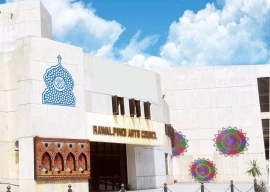
“In the last two decades, the demand for Kashmiri embroidery has increased beyond our imagination,” he says. “The demand is at its peak in the last 10 days of Ramazan.”
Of Eid and excitement
Madina Market is the commercial nerve of Muzaffarabad. This is particularly evident as Eid shopping gains momentum, and women shoppers throng the area to look for the perfect Kashmiri embroidery item.
“I just bought two Kashmiri shawls and three suits with unique Kashmiri stitching and embroidery work,” says Dr Fauzia, a resident of Mirpur. “Madina Market is certainly the hub for all this, known particularly for the unique Kashmiri clothes.
Today, the market, with its variations of Kashmiri karhai (stitching work and embroidery), attracts everyone – from older, professional women to young college girls.
“I’ve been coming to this old market since my childhood,” says Humaira Karim, a university student. “I come here mostly to buy shawls, but now the needlework, with handmade thread, has left me very impressed.”
According to Sheikh, the demand gets so high before Eid and the wedding season that embroidered items have to be purchased from Srinagar, in Indian Kashmir. “These are obviously more expensive than local stitching,” he explains.
Aside from the traditional Kashmiri karhai and shawls, Swati and Multani needlework is also in demand.
Let’s talk costs
Shopkeeper Yousaf Butt says Kashmiri threadwork can be affordable for everyone, depending on thread quality and quantity, and also fabric.
“The same work with cotton thread can be done on suits, shawls, saris, bridal dresses and even bedsheets,” says Butt. “However, good Kashmiri embroidery items are costly, ranging from Rs5,000 to Rs40,000.”
Tricks of the trade
Previously, the designing work was almost exclusively all done by people who migrated from Indian Kashmir in the 1990s. Now, even local designers are doing great work.
“A good number of young girls in Muzaffarabad are stitching and doing needlework at home using cotton threat,” says Manzoor Ahmad Sheikh, owner of the Srinagar Shawl House and Karhai Centre in Madina Market. “This is how they are making ends meet. People from other parts of AJK and the families of Kashmiri Diaspora are their main customers.”
The end product is often the result of a meticulous process. “Before stitching, these Kashmiri dresses are tailored through a proper technique to ensure their fitting,” explains Yousaf Butt. “Today, there are literally thousands of items for customers to choose from.”
Published in The Express Tribune, August 1st, 2013.
COMMENTS (4)
Comments are moderated and generally will be posted if they are on-topic and not abusive.
For more information, please see our Comments FAQ
1732071267-0/lana-(2)1732071267-0-405x300.webp)
1727242355-0/Diddy-(1)1727242355-0-165x106.webp)

1732063440-0/elon-(3)1732063440-0-165x106.webp)













masha allah I do also good in qatar .
Well mentioned ... This is the demand of our Kashmiri culture that we must keep it with us in our daily life ... We belong to the community whose traditions have been reported since the era of Buddha ... Now its our duty to promote , what we belong to ... !!!
Nice article...... Good to see Kashmiri craft is being showcased here. We need to support the artisans and craftsmen more than before. Though we normally look up to the government for bringing in support mechanisms; and it will be good if they do; however, community also needs to rise and nurture the craft of these men and women. A more organized effort. A Kashmiri Craftsmen League / Association would be a great idea. Vocational schools could be a good medium in imparting the skills to the unemployed youth. (Kashmir School of Arts & Crafts seems to be a far-fetched idea, at the moment, but definitely a possibility in future)... Similarly we may dedicate a special area where all the shops are located at one place. This would enhance the quality of artisan-ship also. Almost every city in the world has these kind of shopping areas where one could go and buy the local art products... With the every year growing influx of tourists in the area; one can safely say that the future of art and craft in Muzaffarabad is much bright. At the same time, it will be a means of sustainable livelihoods for unemployed.
Kashmir is a land of visual and material culture. Unfortunately this 65 years War in IHK has ruined our social and material values. However it is a question mark for International peace keeping institutions to stop violence and restore this dying material culture of Jammu and Kashmir.